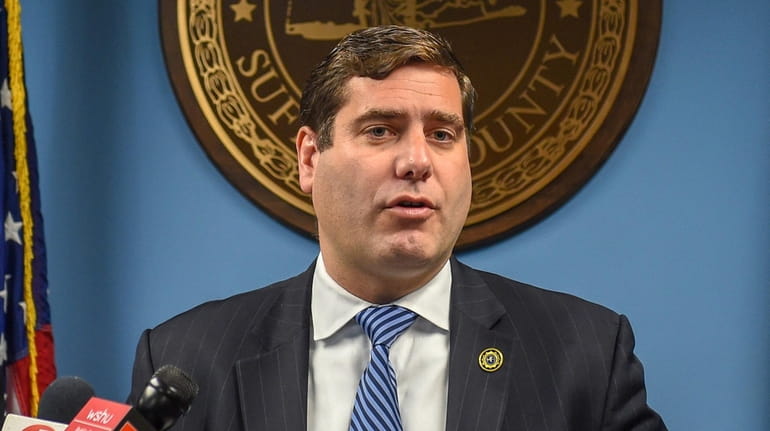Suffolk County widens distribution of gang lists

Suffolk County District Attorney Tim Sini talks during a news conference at his office in Hauppauge on May 14. Credit: James Carbone
Suffolk County officials have expanded distribution of lists of alleged gang members to Islip Town, where the hamlets of Brentwood and Central Islip have been the sites of high-profile gang killings since 2016.
But civil liberties and immigrants rights groups cautioned that such lists and databases can mistakenly include innocent people.
The lists, compiled by the county sheriff’s department and distributed weekly to law enforcement agencies for some time, contain the names of alleged gang members and associates who are released from the Riverhead Correctional Facility and the Yaphank Correctional Facility.
Suffolk County District Attorney Tim Sini’s office began forwarding the sheriff’s lists to town public safety officials in June 2018 to alert officials when alleged gang members who live in Islip are released from jail, in order to combat violence in the community.
“We’ve prevented murder with this intelligence sharing,” said Sini, a former Suffolk police commissioner. “We’ve provided instrumental, critical social support in times of crisis through intelligence sharing.”
Attorneys along with civil liberties and immigrant rights groups say lists and databases can include people who have no proven gang associations. People rarely know they are on such lists, and it’s difficult to get taken off them, attorneys and activists say.
“Allegations of gang affiliation should not become a scarlet letter that community members carry around for the rest of their lives,” said Irma Solis, the New York Civil Liberties Union’s Suffolk director.
The widening distribution of the lists comes as law enforcement officials are boosting coordination in an effort to prevent gang violence on Long Island.
The increased intelligence sharing is part of a broader anti-gang effort involving local law enforcement and the federal Department of Homeland Security. The department, which includes U.S. Immigration and Customs Enforcement, has access to the Suffolk intelligence upon request and meets regularly with local agencies, a sheriff’s official said.
For at least the last three years, the Suffolk sheriff’s office has issued weekly notifications of the release of alleged gang members from the county jail to law enforcement agencies throughout the region, including police departments in Nassau, Southampton, Riverhead, New York City and Rockland County, officials said.
The county sheriff’s office also notifies agencies outside the state if inmates list their addresses there, although the majority of inmates are from Suffolk, said Undersheriff Kevin Catalina, who commanded the NYPD’s gang unit from 2014 to 2016.
Sheriff’s officials said they originally began compiling data on alleged gang affiliations in an effort to improve jail security by ensuring rival gang members were not housed together.
The data are stored in the jail computer system that also includes photographs, biographical information, disciplinary and visiting history, court dates and emergency contact information, Chief Michael Sharkey said. Criminal histories are not stored in this system.
In 2002, the sheriff began informing the Suffolk Police Department when alleged gang associates were released from jail. The police department also keeps a gang database.
Suffolk Police Commissioner Geraldine Hart, who once led the FBI’s Long Island Gang Task Force, called the police databases “an essential intelligence-gathering tool to track and combat criminal groups. The information entered provides law enforcement with data that can be used to prevent retaliatory violence and can guide the department in creating alternatives to gang life for young people.”
Islip public safety officials put the gang information into a database used to track property code enforcement cases, public safety Commissioner Anthony D’Amico said. The information helps code enforcement officers, fire marshals and environmental control employees prepare when they are sent to homes where alleged gang members live, D’Amico said.
Only supervisors and investigators involved in code enforcement cases can see the gang information.
D’Amico said enforcement officers do not target properties because alleged gang members live there.
“It’s more of a safety aspect for our guys,” D’Amico said. “We won’t change our style of enforcement on somebody because they were in jail.”
Gang databases have been controversial in New York and across the nation for years.
In 2018, the Legal Aid Society sued the NYPD for records related to its gang database, alleging gang policing tactics largely target communities of color.
Legal Aid said the majority of the 17,000 people in the database were Latinos and African-Americans, who were subjected to increased police surveillance and raids. The parties reached a settlement in March, with the NYPD agreeing to disclose records, according to court records.
In California, officials are examining policies for law enforcement use of a statewide database called CalGang after an audit found it contained numerous errors.
The database of about 150,000 people included 42 infants and 600 people who should have been removed from the list after five years if they’d had no contact with police, the audit found. The U.S. Department of Justice recommends purging such lists every five years.
Lawyers, civil rights groups and immigrant rights groups say that, in New York, people have been falsely labeled as gang members for being from the same low-income and minority areas where known gang members live; being seen talking to gang members, even if they are students in the same high school; or wearing clothing with colors such as MS-13’s blue and white.
Those identified as gang members or associates can lose jobs, be detained without evidence, receive higher bail amounts, have their immigration status changed or be deported, the advocates said.
Emily Torstveit Ngara, director of the Deportation Defense Clinic at Hofstra Law School, said such broad criteria lead authorities to dissect what young men and women, particularly Latinos and other people of color, are wearing and “every move they make.”
“It’s just policing every aspect of these kids’ lives and subjecting them to way more scrutiny than their peers who are white, for example,” Ngara said
Bryan Johnson, an immigration attorney based in Bay Shore, said he has had clients who are victims of MS-13 gang violence who mistakenly have ended up on gang lists after cooperating with police because that connects them to the gang. It is a label “that sticks with them for life.”
“If a client tells me, ‘I have trouble with MS-13,’ I don’t tell them to go to the police,” Johnson said. “I tell them to get out of Suffolk County.”
Johnson said he has represented at least a dozen clients erroneously included on gang lists and databases.
The Suffolk County Police Department, which launched its own gang database in 1999, did not provide specific answers to questions about its gang databases or how it determines who belongs on them. There are an estimated 400 confirmed MS-13 gang members in the county, police said.
In a statement, the department said it “may confirm someone to be a member of a specific organization using criteria consistent with law enforcement agencies across the country.”
The Nassau County Police Department also maintains a gang database. The department uses a rating scale of 1 to 5 to determine gang membership, Commissioner Patrick Ryder has said. Nassau police and sheriff’s officials did not respond to requests for comment last week.
Suffolk County officials say while they are sensitive to the issue of inappropriate placement on gang lists, such databases can be used to help build court cases and prevent violence.
If a gang member is murdered, for instance, law enforcement agencies can check gang lists and databases to determine which gang he or she belonged to and identify rivals. Police then can deploy officers to areas where rival gangs operate to try to prevent retaliatory violence, said Undersheriff Catalina.
“These lists were created and exist to keep gang members and their rivals safe, as well as the residents of Suffolk County,” said Catalina.
And “for us to designate somebody, we’d have to be 100 percent certain,” he said.
Catalina said he is looking to purge the database every two years to remove people that may have turned their lives around.
Steven Troyd, Southampton Town’s public safety commissioner, said sharing gang information among law enforcement agencies can expedite investigations and strengthen allegations in racketeering cases.
Law enforcement should verify the information and make sure there is enough evidence of gang membership, Troyd said.
“You have to be cautious with civil liberties,” said Troyd, who served on the FBI’s Long Island Gang Task Force for 12 years. “You have to know your sources.”
Suffolk sheriff’s officials said they use an extensive checklist with strict criteria to determine gang affiliation. They did not detail the criteria except to say they can include tattoos, affiliation and self-admission. The charges against inmates are not necessarily relevant in determining gang affiliation, Catalina said.
Suffolk Sheriff Errol Toulon noted that, in the jails, officials have access to gang members and associates and time to interview them repeatedly to learn about gang membership, leadership and factions.
There are 303 inmates classified as gang members or associates in the Yaphank and Riverhead jails, where inmates typically are awaiting trial or, if convicted, are serving sentences of up to a year, sheriff’s officials said.
Correction: Suffolk County's Riverhead Correctional Facility is located in Southampton Town in the hamlet of Riverside. A story in editions published July 2 misstated the facility’s location.
Gilgo-related search in Suffolk woods ... Urologist trial update ... Construction work zone safety ... Jericho fatal crash
Gilgo-related search in Suffolk woods ... Urologist trial update ... Construction work zone safety ... Jericho fatal crash

